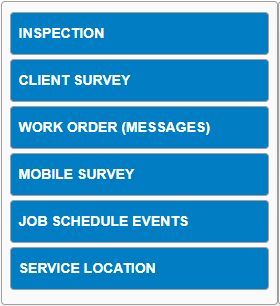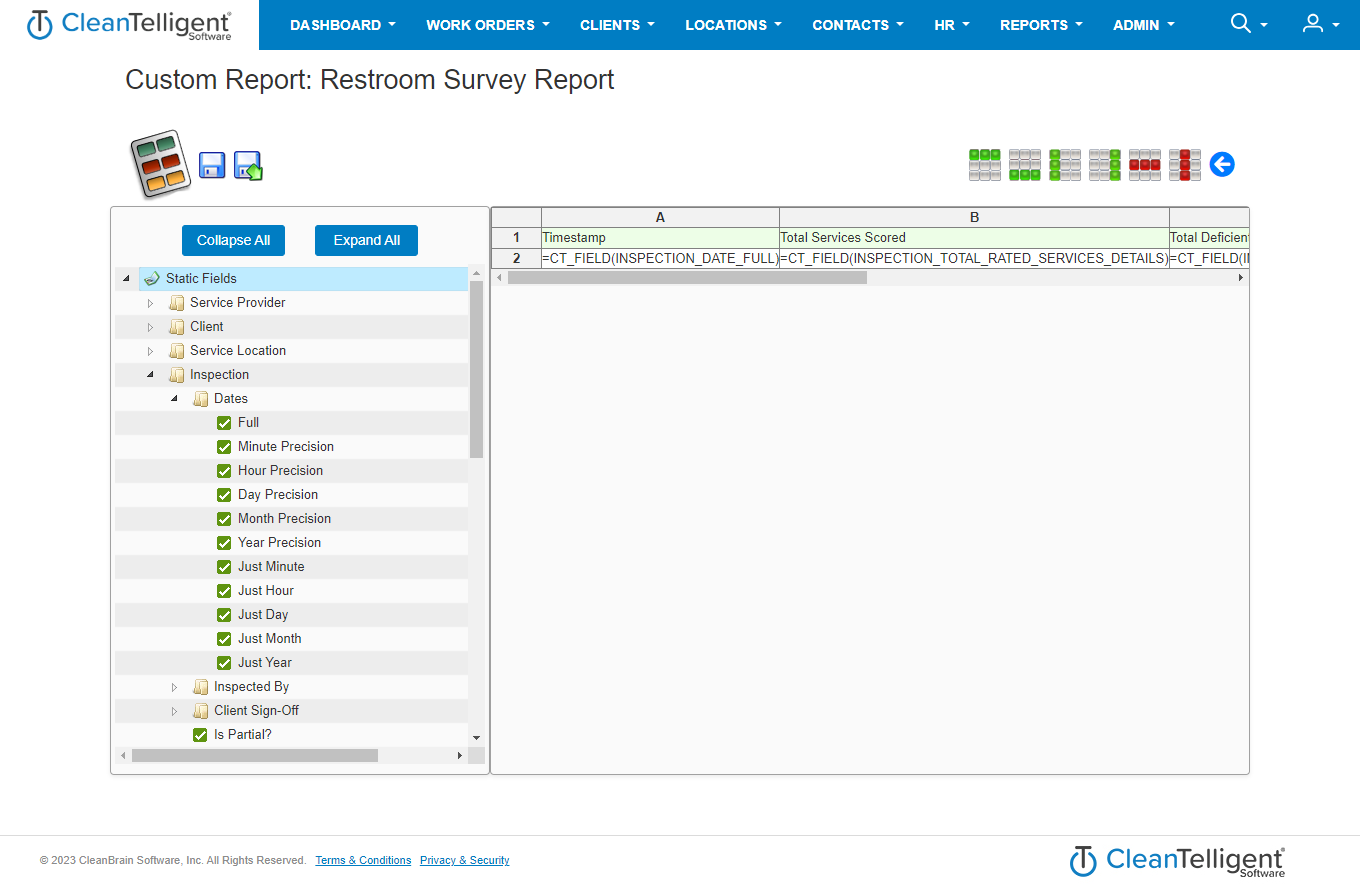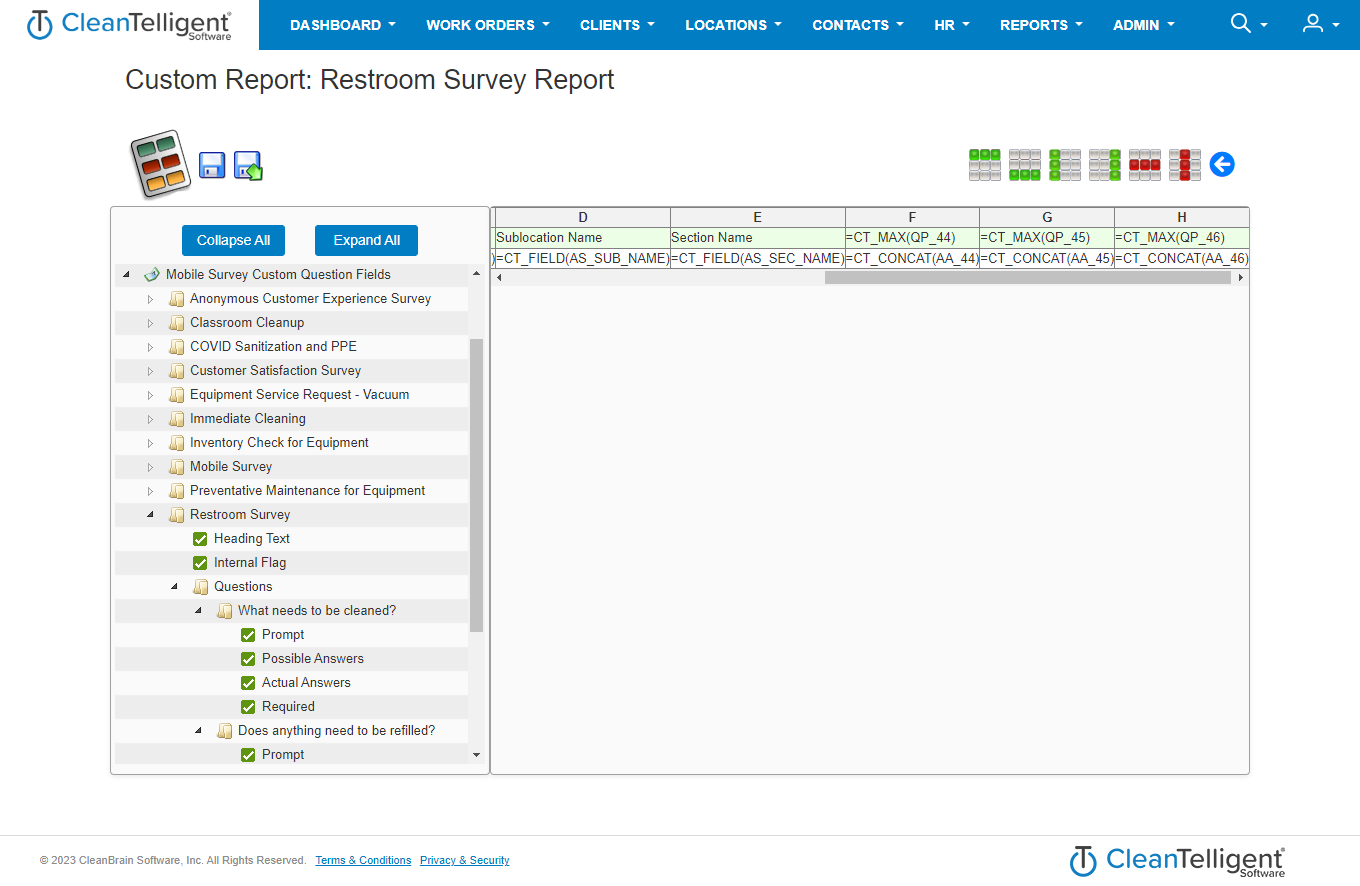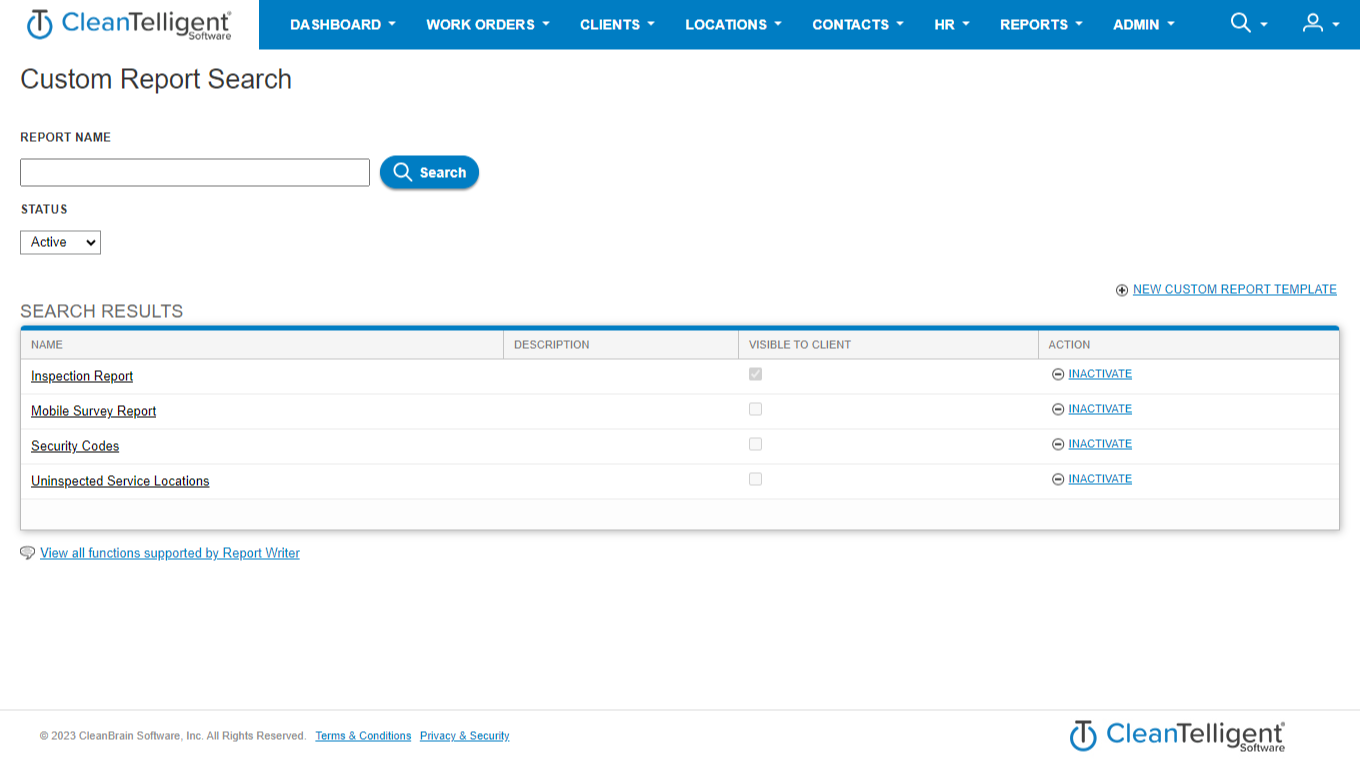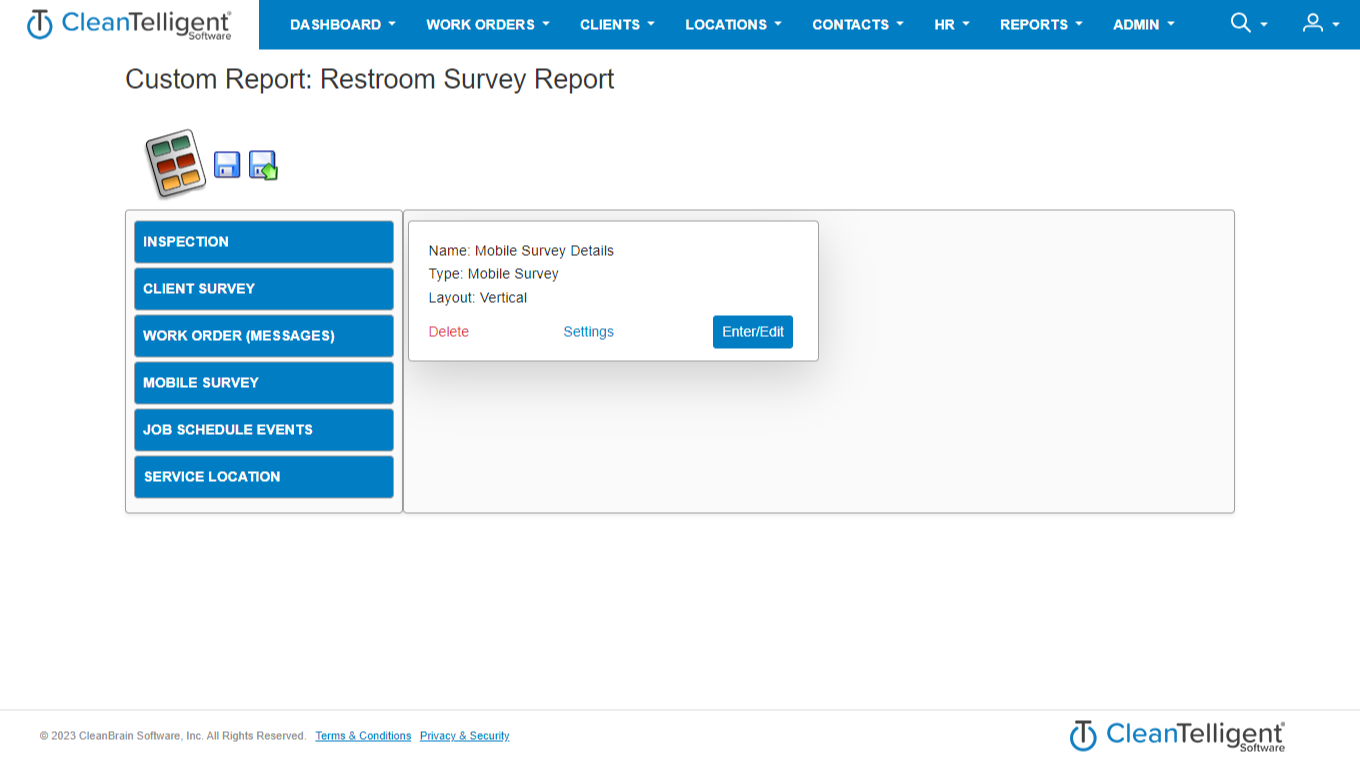Report Writer
Transcript:
Today we will go over how to create a custom report in Report Writer. The reports will always be viewed in Microsoft Excel.
To start, go to the Admin tab and click Configuration. Then under Job Configuration, click Report Writer. Click New Custom Report Template at the top right of the Search Results window. This opens a new window.
In the Report Details window that pops up, enter the name of the report. I’m going to be creating an inspection report, so I will name it Inspection Report. If you know that you want your client customers to be able to access this report, make sure to click External, here, to make it external so that they can see it.
Next, click on and highlight Inspection and drag and drop it into the white space. A new Sub Report Details window pops up. Fill in the name (I would name it the same report name again). So, Inspections Report is what we will call it. Add a description, if you like, but it’s not needed as the name already refers to what this is. Then hit Save.
Click Edit to open the next window. Here you’ll start setting up your custom report.
You will see a brownish-red area where you will create new cells by clicking on the plus sign on the right, to add more cells here. If you know the number of columns you’ll need — let’s say seven — you’ll click six times, because one column is already created. You’ll notice they’re labeled alphabetically at the top.
These brown rows are where you will drag and drop the formulas in.
Click on the top addition button to add a header row. These are your green rows. This is where you will put the title for each column as you create the report.
Next, click on the Inspection down arrow in your list to the left.
I’m going to pull in the Name of the Service Location, the Dates of the inspections, Inspected By and the scores. I will also name each of the columns after these.
I drag over my service location Name and then type this in row 1, under column A.
Next, I will drag in under the Inspection file, the dates of inspections. I want the Full date, so this is what I drag in. Then type in the name at the top again.
Then I want who performed the inspection. This has First Name and Last Name cells, so I will put each in a separate column and type in their heading at the top of each.
I want to make sure I pull in the scoring information, so I will pull in the Inspection Service Detail Score, name that at the top, and I also want what our goal score is set at this location. So, I pull that information over and title that column also.
I’m done pulling in the information I would like, so I’ll click Save in the top left and then click on Backand it takes me back to the Search Results.
Now, to run this report, I go to Reports, Custom Reports and click on the report I just created. Mine was Inspection Reports.
A new window pulls up where I can enter a date range and then select Select All or anything here I’d like to under the Selection Criteria.
Once selected, click View Report at your top right or bottom right. Then it should pull up your report in Excel. Name it and save it and open it and you’ll see your new Excel Custom Report!
Report Writer Article
- Custom Report Template: This is like a blueprint for your custom reports. It specifies what data you want, how it should look, and where it comes from. It's made up of fixed, customizable, and job-specific fields.
- Datasets: These are collections of data sources you can use in your custom report. They cover everything from events to specific custom data tied to clients, including questions from various scenarios. Examples of datasets include inspections, client surveys, and work orders.
- Static Fields: These are standard data fields that all Otuvy QM accounts have. For instance, client names, service location names, and dates are static fields.
- Custom Question Fields: These are questions and their answers that can be linked to different records or events, like service providers, clients, inspections, and surveys.
- Repeating Data Row : This is a row (the only one with a white background) that repeats for each instance of data you're reporting on. For example, if you're reporting on inspection scores by sublocation, this row will repeat for each sublocation, showing their scores.
- Header Row: These are rows (usually with a green background) that give context to the data in the repeating data row. They are static and don't repeat. You can use them as section headers.
- Footer Row: Similar to header rows, these are rows (usually with a brown background) that usually appear once. They're often used to calculate totals or averages of the rows above them using functions.
- Report Flow: This refers to how the data is organized in the report. There are two main types:
- Vertical: This is the standard flow where headers are at the top, data rows follow, and footers are at the bottom.
- Horizontal: This flips the report on its side. Headers become leftmost columns, data rows become columns from left to right, and footers become rightmost columns.
- Functions: These are tools you can use to manipulate the data in your report. They're like built-in functions in Excel. You can check the list of supported functions by clicking the "View all functions supported by Report Writer" link on the Custom Report Search page.
- Click the Admin tab to be brought to the Service Provider Configuration page
- In the Job Configuration section, click Report Writer
- From the Custom Reports Search page you can
- Search active and inactive custom reports
- Create a New Custom Report Template
- Edit existing custom reports
- Make custom reports visible to your clients
- View all functions supported by Report Writer
- Click New Custom Report Template from above the Search Results pane to start
- Fill out the Report Details :
- Name: What your users will see as they pick what custom report to run
- Description: A brief description of what the user should expect to be output from the report
- Visible to Client: Check this box if you want both Contact and Employee Users to be able to see and run this report. Leave it unselected if you only want Employee Users to see it.
- Click OK
- Drag the Data Set from the left that you want in your report. You can have up to four (4) Data Sets in any custom report, but most people only use one.
- Each Data Set you bring in will have the following in common:
- Name
- Description
- Report Flow
- Group By: This allows you to group the data which is output by Client, Location, etc. Or you can have all the information collated together.
- Some Data Sets have additional features
- Click Add Left Column or Add Right Column to add Columns of data to the left or right of current columns.
or - New columns will always be added to the left or right of the existing columns. There is not a way to reorder the columns
- Add Header Rows by clicking Add Top Row
- New header rows will always be added above the existing rows. There is not a way to reorder the rows.
- Add Footer Rows by clicking Add Bottom Row
- New footer rows will always be added below the existing rows. There is not a way to reorder the rows.
- Delete Rows or Columns by selecting a cell in the row or column you wish to delete and then click either Delete Row or Delete Column
or - Input the expected cell data by
- Manually Input Text: Most headers will use manually input text like "Client Name", "Location Name", or "Average Score"
- Use Static and Custom Question Fields from the Data Set: Most of the time this information will be dragged from the left into a cell in the Repeating Data Row.
- Occasionally some of this will be added to either the Header or Footer Rows. Some examples could be the Prompts or Possible Answers for your Custom Question Fields
- Use Functions: Manipulate the data and embed Excel functions into the data output.
- Save your template once you have all the information you want
- Save: Saves and updates the template
- Save As: Keeps the old version of the template and creates a new one with the changes you have made
- Hover over the Reports tab and click Custom Reports
- Run the new custom report
- You'll need to select the correct Date Range and Selection Criteria

Related Articles
Custom Reports for Mobile Surveys
Mobile surveys, if they generate work orders, display answers in reports like Message History or Work Order reports. However, these reports don't break down question-answer relationships. For detailed analysis, consider creating a custom report using ...Filing Type Tracking by Month Report
In this article, we go over the Filing Type Tracking by Month report within CleanTelligent. As a pre-requisite to this article, please check out the article Using Filing Types The Filing Type Tracking by Month report is used to track what filing ...Average Inspection Scores Report
Transcript: This video is to show how to run the Average Inspection Scores report. Start by clicking on the Reports tab. The Average Inspection Scores report is located in the first section. There are two output types, PDF Report and MS Excel. Choose ...Inspection Summary Report
Transcript: This video is to show how to run the Inspection Summary Report. Start by clicking on the Reports tab. The Inspection Summary Report is located in the first section. Choose the location and then the specific inspection you want to view in ...Job Schedule Report
Transcript: This video is to show how to run the Job Schedule Report by Employee/Contractor. Start by clicking on the Reports tab. The Job Schedule Report by Employee/Contractor is located in the Miscellaneous Reports section. Choose your Output ...
